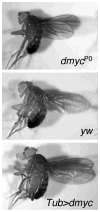Myc in model organisms: a view from the flyroom
- PMID: 16916612
- PMCID: PMC2850916
- DOI: 10.1016/j.semcancer.2006.07.010
Myc in model organisms: a view from the flyroom
Abstract
The Myc transcription factor regulates fundamental processes in a cell's life: its growth, division, and survival. Myc is conserved throughout metazoan phyla, and its identification in the fruit fly, Drosophila melanogaster has led to new insights in Myc's physiological roles. In this review, we describe recent research on the biology of Myc and its family members in Drosophila, paying particular attention to its role in the control of growth during development.
Figures



Similar articles
-
Myc's secret life without Max.Cell Cycle. 2009 Dec;8(23):3848-53. doi: 10.4161/cc.8.23.10088. Epub 2009 Dec 15. Cell Cycle. 2009. PMID: 19887915 Review.
-
Max-independent functions of Myc in Drosophila melanogaster.Nat Genet. 2008 Sep;40(9):1084-91. doi: 10.1038/ng.178. Nat Genet. 2008. PMID: 19165923
-
Growth control: Myc and Yorkie get connected.Curr Biol. 2011 Jan 11;21(1):R37-9. doi: 10.1016/j.cub.2010.11.057. Curr Biol. 2011. PMID: 21215937
-
Drosophila Myc.Adv Cancer Res. 2009;103:111-44. doi: 10.1016/S0065-230X(09)03005-X. Adv Cancer Res. 2009. PMID: 19854354 Review.
-
The conserved Myc box 2 and Myc box 3 regions are important, but not essential, for Myc function in vivo.Gene. 2009 May 1;436(1-2):90-100. doi: 10.1016/j.gene.2009.02.009. Epub 2009 Feb 24. Gene. 2009. PMID: 19248823
Cited by
-
Sexual Dimorphism of Body Size Is Controlled by Dosage of the X-Chromosomal Gene Myc and by the Sex-Determining Gene tra in Drosophila.Genetics. 2017 Mar;205(3):1215-1228. doi: 10.1534/genetics.116.192260. Epub 2017 Jan 6. Genetics. 2017. PMID: 28064166 Free PMC article.
-
Mechanisms of growth and homeostasis in the Drosophila wing.Annu Rev Cell Dev Biol. 2009;25:197-220. doi: 10.1146/annurev.cellbio.24.110707.175242. Annu Rev Cell Dev Biol. 2009. PMID: 19575645 Free PMC article. Review.
-
TEAD1/4 exerts oncogenic role and is negatively regulated by miR-4269 in gastric tumorigenesis.Oncogene. 2017 Nov 23;36(47):6518-6530. doi: 10.1038/onc.2017.257. Epub 2017 Jul 31. Oncogene. 2017. PMID: 28759040 Free PMC article.
-
Integration of Insulin receptor/Foxo signaling and dMyc activity during muscle growth regulates body size in Drosophila.Development. 2009 Mar;136(6):983-93. doi: 10.1242/dev.027466. Epub 2009 Feb 11. Development. 2009. PMID: 19211682 Free PMC article.
-
The transcription factor Nerfin-1 prevents reversion of neurons into neural stem cells.Genes Dev. 2015 Jan 15;29(2):129-43. doi: 10.1101/gad.250282.114. Genes Dev. 2015. PMID: 25593306 Free PMC article.
References
-
- Gallant P. Current topics in microbiology and immunology. Springer-Verlag; 2006. Myc/Max/Mad in invertebrates: the evolution of the Max network; pp. 237–54. - PubMed
-
- Schreiber-Agus N, Chin L, Chen K, et al. Evolutionary relationships and functional conservation among vertebrate Max-associated proteins: the zebra fish homolog of Mxi1. Oncogene. 1994;9(11):3167–77. - PubMed
-
- Yuan J, Tirabassi RS, Bush AB, Cole MD. The C. elegans MDL-1 and MXL-1 proteins can functionally substitute for vertebrate MAD and MAX. Oncogene. 1998;17:1109–18. - PubMed
-
- Lindsley DLaZ GG. The genome of Drosopahila melanogaster. Academic Press; 1992.
Publication types
MeSH terms
Substances
Grants and funding
LinkOut - more resources
Full Text Sources
Molecular Biology Databases

